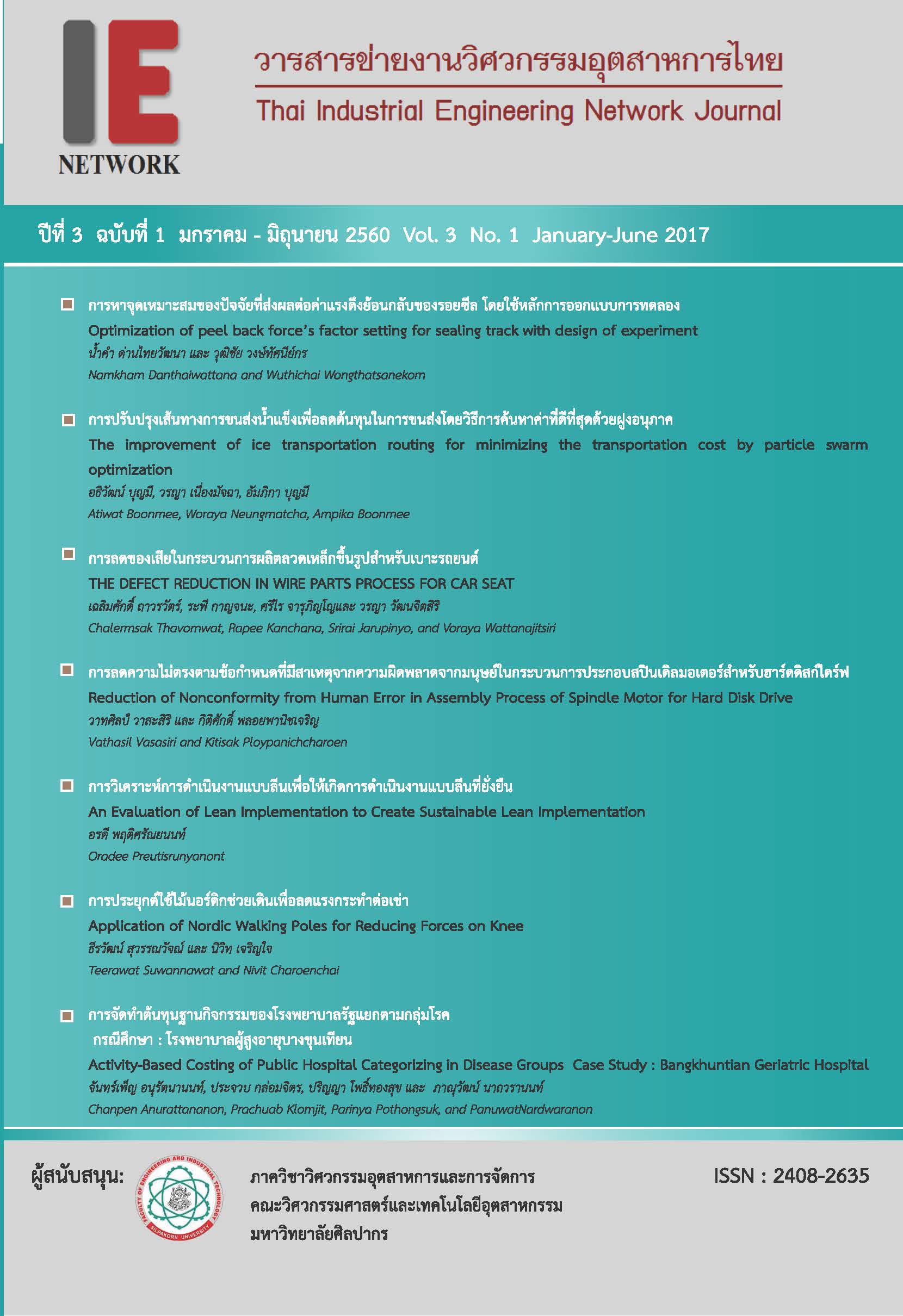Reduction of Nonconformity from Human Error in Assembly Process of Spindle Motor for Hard Disk Drive
Main Article Content
Abstract
This research quested for dent and/or scratch problem in spindle motor for a hard disk drive industry. It initiated the vital few of cost of poor quality in the sample company. The Alpha-1 at OD position, spindle motor’s model, in rotor assembly process was the scope of this study which can reflect the problem. The proportion, dent and/or scratch at OD position of total production input, was 710 ppm and management aimed at 280 ppm. Principal Component Analysis founded the first component contributed for 75.6% of total variation. The subjective interpretation of contributor was human error. To achieve the target, problem must
be reduced 60.8% of total problem which mathematically implied 80.4% of total human error. The research journey started at measurement system evaluation and analysis which founded those effectiveness indices of measurement system, dent and scratch at OD position, were unacceptable in both of miss alarm (IMISS) indices and false alarm (IFA) indices. To eliminate the causes from measurement, method of inspection was improved and operators were retrained after improvement. In RCA part, human error was analyzed by system approach. It generated the hypothesizes which were physical fatigue of operators, circadian rhythm of operators, work environment between morning shift and night shift, lack of an accountability system, the difference method between machines and the difference skill of operators from team rotation. The 2-Proportion test was implemented to prove the causes from human error. The study founded that the difference skill of operators from team rotation and lack of an accountability system was significant for improvement. The P-Values of the average proportion of dent and/or scratch at OD position were 0.0001 and 0.0019 respectively. In order to counter the causes, operation was redesigned to reduce skill-related work and process of accountability was fulfilled in operation. The result of these countermeasures shall reduce the operation which relies on operators’ skill and shall increase human awareness. The average proportion of dent and/or scratch, OD position, shall approximately achieve the target at 276 ppm.
Article Details
บทความ ข้อมูล เนื้อหา รูปภาพ ฯลฯ ที่ได้รับการตีพิมพ์ในวารสารฯ ถือเป็นลิขสิทธิ์ของวารสารฯ หากบุคคลหรือหน่วยงานใดต้องการนำทั้งหมดหรือส่วนหนึ่งส่วนใดไปเผยแพร่ต่อหรือเพื่อกระทำการใดๆ จะได้รับอนุญาต แต่ห้ามนำไปใช้เพื่่อประโยชน์ทางธุรกิจ และห้ามดัดแปลง
References
[2] Santhirathai S., Thailand: What 20 months of manufacturing declines imply, Fixed Income Research, Credit Suisee, January 2015
[3] เสาวณี จันทะพงษ์ และคณะ, กระบวนการปรับโครงสร้างเศรษฐกิจไทยในปัจจุบันและทิศทางข้างหน้า: วิเคราะห์จากมุมมองตลาดแรงงาน,ธนาคารแห่งประเทศไทย, สิงหาคม 2558, หน้า 18-31
[4] Lanvin B. and Evans P. (Eds.), 2014, The Global Talent Competitiveness Index 2014, Adecco, December 2014, Singapore, p.208
[5] วาทศิลป์ วาสะสิริ, 2558, การลดความไม่ตรงตามข้อกำหนดที่มีสาเหตุจากความผิดพลาดจากมนุษย์ในกระบวนการประกอบสปินเดิลมอเตอร์สำหรับฮาร์ดดิสก์ไดร์ฟ, วิทยานิพนธ์ปริญญาวิศวกรรมศาสตรมหาบัณฑิต, สาขาวิชาวิศวกรรมคุณภาพ, คณะวิศวกรรมศาสตร์, มหาวิทยาลัยเทคโนโลยีพระจอมเกล้าธนบุรี
[6] ปราณิดา ศยามานนท์, ธุรกิจชิ้นส่วนอิเล็กทรอนิกส์…ฟื้นหรือฟุบยาวจากวิกฤติน้ำท่วม, ศูนย์วิจัยเศรษฐกิจและธุรกิจ ธนาคารไทยพาณิชย์, พฤศจิกายน 2554
[7] ณาตยา แดงรุ่งโรจน์, 2556, ความสามารถในการแข่งขันส่งออกฮาร์ดดิสก์ไดร์ฟของประเทศไทยกับประเทศสมาชิกอาเซียน 4 ประเทศ, วิทยานิพนธ์ปริญญาบริหารธุรกิจมหาบัณฑิต สาขาการจัดการวิสาหกิจสาหรับผู้บริหาร บัณฑิตวิทยาลัย สถาบันเทคโนโลยีไทย-ญี่ปุ่น, หน้า 30-31
[8] Anand R., Kevein C.C., Reman S. and Zhang L., Potential Growth in Emerging Asia, IMF Working Paper, January 2014 p.12
[9] พินท์สุดา แก้วแจ่มศรี, 2551, การลดจำนวนอนุภาคปนเปื้อนบนเบสในกระบวนการประกอบสปินเดิลมอเตอร์, วิทยานิพนธ์ปริญญาวิศวกรรมศาสตรมหาบัณฑิต สาขาวิศวกรรมคุณภาพ คณะวิศวกรรมศาสตร์ มหาวิทยาลัยเทคโนโลยีพระจอมเกล้าธนบุรี, หน้า 44-45
[10] มนตรี ก่อพงศ์เจริญชัย, 2551, การลดของเสียประเภทชิ้นงานฮับเอียงในกระบวนการกลึงชิ้นงานของสปินเดิลมอเตอร์สาหรับฮาร์ดดิสก์ไดร์ฟ, วิทยานิพนธ์ปริญญาวิศวกรรมศาสตรมหาบัณฑิต สาขาวิศวกรรมคุณภาพ คณะวิศวกรรมศาสตร์ มหาวิทยาลัยเทคโนโลยีพระจอมเกล้าธนบุรี, หน้า 43-46
[11] กิติศักดิ์ พลอยพานิชเจริญ, การวิเคราะห์ระบบการวัด (MSA) (ประมวลผลด้วย Minitab 15), พิมพ์ครั้งที่ 7, 2553, สมาคม ส่งเสริมเทคโนโลยี (ไทย-ญี่ปุ่น), กรุงเทพฯ, หน้า 216-240
[12] Reason J., Human error: Models and management, British Medical Journal, vol. 320 issue 7237, March 2000, pp.768–770.
[13] Rooney J.J., Lee N., Heuvel V. and Lorenzo D.K., Reduce Human Error, Quality Progress, Vol.35 No.9, September 2002, pp.26-36
[14] Harvey T., 2014, Reducing Frequency and Lowering Severity of Human Error : Optimize Performance, ASSE Professional Development Conference and Exposition, 8-11 June 2014, Orlando, Florida USA
[15] Dekker S., The Field Guide to Understanding ‘Human Errors’, Ashgate, 3rd edition, 2014, Farnham, pp.1-25
[16] โอกุระ ฮิโตชิ (วิเชียร เบญจวัฒนาผล และสมชัย อัครทิวา แปล), Why-Why Analysis สำนักพิมพ์ ส.ส.ท., พิมพ์ครั้งที่ 6, 2549, กรุงเทพ
[17] Latino R. J., Latino K. C., and Latino M. A., Root cause analysis: improving performance for bottom-line results, 4th edition, 2011, Taylor and Francis, USA, pp.89-90
[18] Juran J.M., The Quality Improvement Process, Juran’s Quality Control Handbook, 5th edition, 1999, Singapore, pp.5.58-5.64
[19] Fleming, J. H., Coffman, C., and Harter, J. K., “Manage Your Human Sigma, Harvard Business Review, Vol. 83 No. 7-8, July-August 2005, pp. 106-114.
[20] Myszewski, J.M., 2010, Mathematical Model of the Occurrence of Human Error in Manufacturing Processes, Quality and Reliability Engineering International, Vol. 26 No. 8, pp.845-851.


